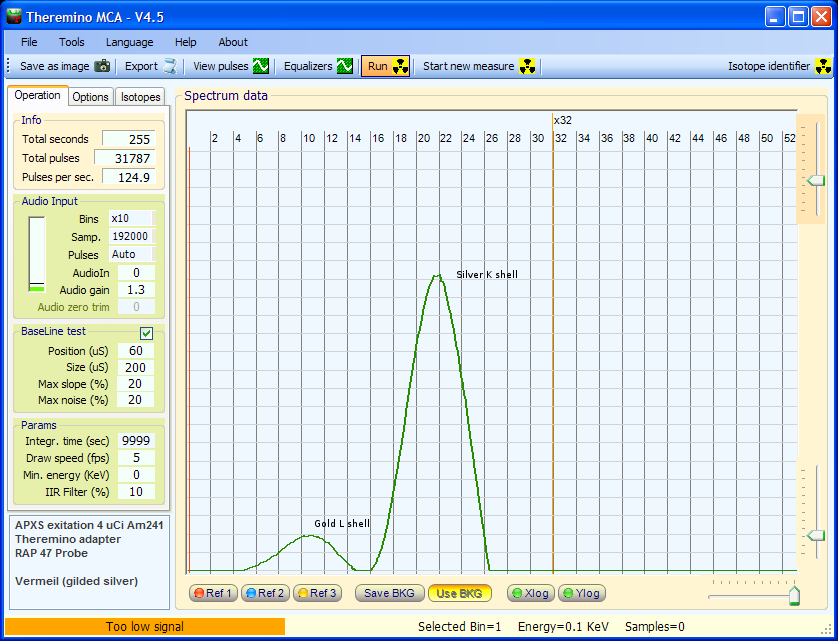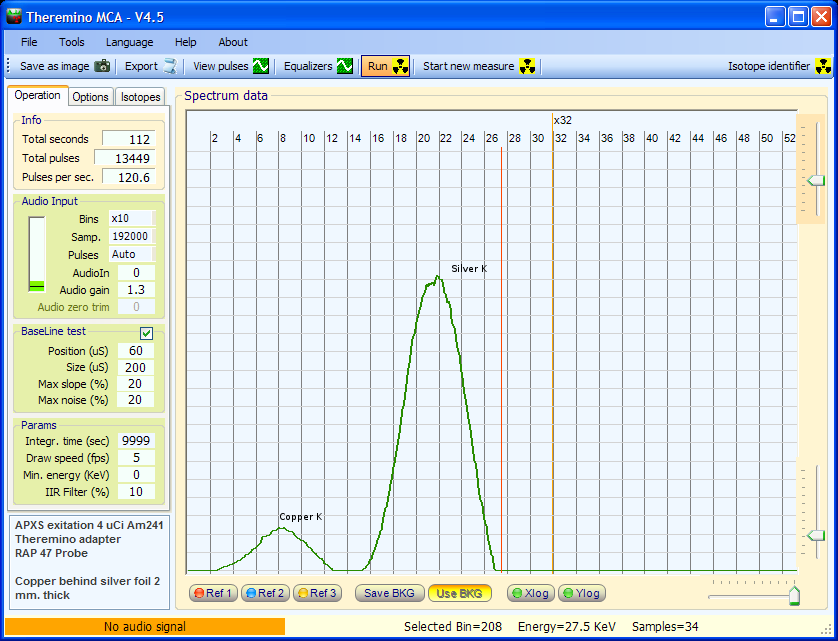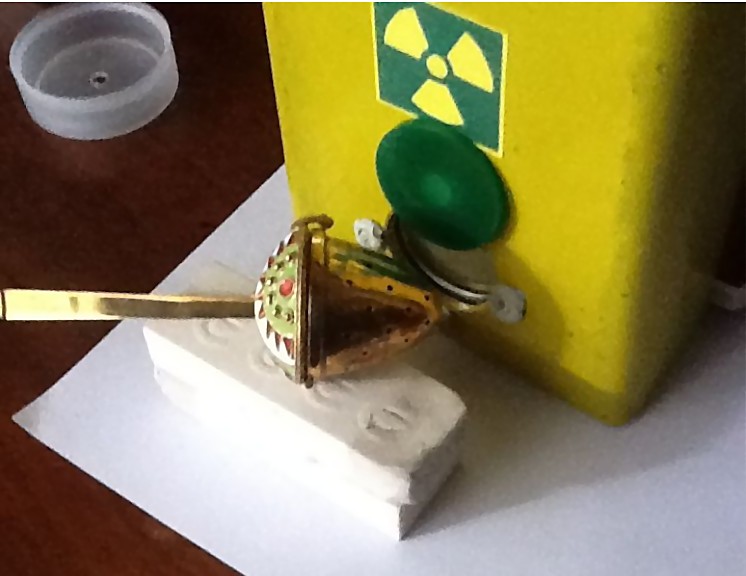X Ray Fluorescence
Illuminating radioactive substances with a radioactive source you excite the electrons of their atoms which then decays emit energy x-ray characteristics. For example,, in the image above, concerning analysis of silver gilt, Silver features energies were detected (electronic shell K ) and dell’ Gold (electronic shell L).
With this technique you can distinguish many materials, including silver, and even see through the plating, What is the base material.
With the energy that we provide is most likely to affect the electrons in the first shell (K), the innermost (less energy). The vacuum must be filled necessarily (to the laws of quantum mechanics) from another electron, from an outer shell and then with greater energy. Excess energy is emitted as photons with an energy characteristic that depends on the item and the electronic shell interested. The electronic shell concerned depends on the energy that we provide. Using americium (59 Kev). We can only examine substances with binding energies, in K shell, less than about 50 Kev – for metals with high binding energies we can examine the second shell, named L, and through this we can analyze most elements atomic number, like gold.
Documentation about XRF techniques
This four-page white paper explains everything you need to know about XRF techniques. The document also contains reference tables on the energies of the most important elements for these analyses. Everyone should download it and keep it handy.
XrayFluorescence_ITA
XrayFluorescence_ENG
Those wishing to make fixes and translations into other languages can download this compressed file that contains the originals in ODT format (Open Office): XrayFluorescence_ODT_Files
XRF Searches
Many researchers are active in research and XRF are already available guidelines for building efficient and simple sensors.
The recommendations to minimize the noise PmtAdapter
http://pico.dreamhosters.com/ThereminoPmtAdapter.html
The most interesting links:
http://pico.dreamhosters.com/XrfSpectrums.html
http://pico.dreamhosters.com/XrfSpectrumsPartTwo.html
http://pico.dreamhosters.com/XrfFluteSpectrums.html
http://pico.dreamhosters.com/ThereminoMcaSpectrums.html
In the following PDF file you see a great realization of probe for low energies. The quality of the probe is great, in a very short time of only 120 seconds, provides precise and obvious lines. In addition to the construction of the probe on file shows the lines of many materials including Zinc, Copper, Silver, Gold, White Gold, Nickel, Carbon steel and thin gold Plating. Low energie.pdf probe (file posted by Mario Mueller of death on Gamma Spectrometry in this forum messaggio_12740)
Research on antiques
This file: Test_Sr90_Am241 view part of our research collaborator. This is a comparison between the illuminator and Sr-90 Am-241. The best results were obtained with 4 uCurie of americium placed in 4 buttons all around a ring of lead shielding that prevents gamma radiation of americium to directly hit the Crystal scintillator.
This second file: Tibetan_InkPot_And_Container view tests on some Tibetan objects. NET and precise results. And’ now proved that with americium can do precision analysis in a very short time.
This image shows a filter for herbal infusions purchased in Russia, in a store for foreigners, at the time of Gorbachev. Had been sold as silver gilt – XRF analysis shows that the salesman had told the truth. In this picture the illuminator is the green plastic disk containing Sr-90.
In this document a comparison of two seemingly similar objects, the XRF distinguished sharply.
And in this ChineeseFruits a new interesting research. A test on the possibility of revealing the presence of arsenic in the pigments of ancient ceramic objects.
Finally this XRF_Additional_Notes focuses on the differences in results obtained using as illuminator the Sr-90 or the Am-241.
– – – – – – – –




To excite x-ray fluorescence are normally utilized a variety of isotopes, on the basis of the items that you want to locate.
L’ Am-241 is one of the most versatile, being able to excite the fluorescence from copper until tulio (K-shell emission) and the tungsten up to uranium (L-shell emission).
For the lighter elements can’ use of Fe-55, which raises the fluorescence X from sulphur to chrome (shells K) and molybdenum barium enema (Shell L).
We also use Cd-109, SR-90, Cm-244.
Curium is used by Rover sent to Mars to determine the mineral composition of the planet's surface.
A brief explanation of the technique used can be found here:
http://mars.jpl.nasa.gov/msl/mission/instruments/spectrometers/apxs/
More information on APXS here:
http://msl-scicorner.jpl.nasa.gov/Instruments/APXS/
http://mars.jpl.nasa.gov/MPF/mpf/sci_desc.html#APXS
Using the XRF is possible not only to determine the components of a metallic alloy, but also quantitative analysis in the same.
The amount of x-rays emitted by the test substance depends on the concentration of the sample and therefore the width of several peaks is proportional to the quantity of each element present in the alloy.
In practice, measuring the area subtended by the individual spikes (corrected to take account of the difference in efficiency of the sensor to different energies considered) that is proportional to the amount of the element emits x-rays that energy.
For the exam only takes a few minutes, After that you can determine which, for example,, a bronze object consists, always as an example, From 60% of copper and from 40% by pond.
I can't figure out how to link a linear CCD to system theremino there is some documentation about?
Theremino the system communicates with the hardware, using the PIN, lying on Master and Slave modules. And then through the slots, who are the boxes of communication with software.
The PIN can be programmed with about twenty-five types of InOut “precooked”, all of which are analog, or at the very least that can be represented with a single numeric value.
To control and read a CCD, You must exchange digital data, write and read books and follow particular protocols, differ from one model to another. And you cannot pull signals of this type through the pins and slots.
This doesn't mean that you couldn't use a CCD, and let it interact with our applications. But that it should be done through other avenues, for example the USB, exactly as you do with the webcam.
We have not developed anything on the subject but the network are many examples to easily read the CCD of mice (and the like).
If you add some details about what you want to achieve and the initials of the CCD, We can give you some better advice or suggest alternatives.
– – – – – – –
Apparently this type of sensors it reads better in serial and USB. You may start from one of our application, using the serial port and modify it for the particular protocol to sensor.
Some suitable application (with the functions for serial) are these:
https://www.theremino.com/downloads/automation#balancereader
https://www.theremino.com/downloads/radioactivity#bridge
A good example that explains how to read a CCD sensor:
http://www.bidouille.org/hack/mousecam
Another example:
http://spritesmods.com/?art=mouseeye
In many of these projects use an Arduino but really serves no purpose, You can directly use the PC serial (RS232). Or, If your PC doesn't have the serial, There are convenient USB-to-serial adapters, they are cheaper, small and comfortable to an Arduino. And that work for, While the Arduino you should write special firmware.
Thanks Livo, I looked in the meantime I wanted to start with a linear CCD TCD1304AP to get UV-VIS-NIR spectrometer, and learn to control CCD. Because I saw a post on a theremino spectrometer but in fact does not use the theremino but a simple webcam.
My goal was to, Once you learn the basics, also moving on to other more complicated array sensors: I wanted to get myself a camera.
I've already implemented a form of FLIR Lepton http://www.flir.com/cores/content/?id=66257 and an Arduino but this in my opinion is not ideal because I can't communicate fairly quickly with the computer, I'm then using a Raspberry Pi to capture images from the camera but the ideal thing would be to connect the printer directly to the computer and that's why I wanted to use a theremino. The problem is that I think theremino doesn't support well the I2C Protocol and then maybe I'll have to stick with the Raspberry.
To use the i2c you should reprogram the firmware of Theremino Master. So I suggest you continue with Raspberry.
You will need the same program the I2c communication, but you haven't done so already and then know how to do it. Instead to program the Master you should familiarize yourself with the firmware of the PIC and with difficult and little intuitive techniques.
But the best solution is as follows:
Use any Tablet with Windows 10 (starting from 50 Euro) or embedded PC as Meegopad T2 with Windows 10 (great and cost only 87 Euro). These PCs costing just over a Raspberry but are worth much more. Consume more or less the same current, but they are 100 times more powerful, are quadcore, have Ram and HardDisk at will, have WiFi, the Bluetooth, the sound card, battery control, etc..
Then, to connect I2C devices, you could use any USB to I2C. There are various models on eBay, starting from few euros.
And finally you could program comfortably in VbNet, CSharp, CPP or any other preferred language at a high level and communicate with the rest of the system Theremino through the slots.
With XRF spectrometry, you may know any kind of material?
The materials which can be seen depend on the electron orbits, something a bit’ hard to explain. I recommend this to show them:
https://en.wikipedia.org/wiki/X-ray_fluorescence#/media/File:XRFScan.jpg
Anyway, do not expect definite answers and unambiguous. The detectors we use do not narrow lines such as those of this, then substances can give similar spectra to each other and to make sure, you already know what could be done sample.
For narrow lines as in the picture I showed you, should use high purity germanium detectors (HpGe) cooled liquid nitrogen.
With the HPGe detector rows are wide the 0,15%, while with our NaI(TL) we can get to the 7%, then rows 50 times larger. If you look at the image and widen the lines of 50 times, you'll see that a lot of overlap and merge with each other almost.
So it is useless?… I explain to you, living in the land of fires, I lost friends and relatives with cancer and people continue to die.. Unfortunately you gotta eat and you never know what you eat… It is already established that the values of heavy metals in our vegetables are among the thousands and tens of thousands of times higher than the limit values. In addition there are also radioactive substances… You say then that all site tools I do not need anything or can help me figure out if a food is more or less toxic than another…? Make the hair test,, mineralogrammi, cost and is not helping to prevent… Thank you
It is not “perfectly” useless, you can do many analyzes that other methods could not do. For example, find out if an object is gold or fake, and dozens of other useful tests. But you have to know exactly what you are doing, know that that particular analysis is possible, know that expect data and have experience in the interpretation of the spectra.
What would you need is a sci-fi device, that is able to measure microscopic amounts of all substances “sniffing an object”. Not even the most advanced chemical laboratories can do this. For each substance must use different tests and suitable reagents. So too must first know what to look for and then chop, dilute, wait, measure… for this analysis, and cost you more substances measure, and the smaller the amount of those substances, and cost.
There are small appliances, also portable, that reveal various substances. Gas, various fumes, cocaine and other drugs… but they do not serve you any good because they are not able to measure very small quantities of pollutants, for example insecticides, that may exist in foods.
The closest thing to what would serve you a mass spectrometer. They are devices that cost tens of thousands of euros but even they require a special preparation of the samples, depending on the substances to be analyzed.
Here you can find a list of all analytical techniques:
https://it.wikipedia.org/wiki/Categoria:Tecniche_analitiche
but if he finds gold as you say, the same way it can not detect other metals? or it depends on the amount for which it is not possible to detect?…I could also measure at least slightly polluted radioactive parts with for example cesium or other? It does also measure air quality…often there are fires of garbage ,at the level of their sheds…
The XRF analysis can detect only about twenty substances and only if they are in large quantities. For example, a gold-plated ceramic article will give you three or four humps, For Gold, one for the lead that's in the ceramics and the other two for some other ceramic component. But if the points for air or on a food, where there are microscopic amounts of what interests you, you'll see only the food (provided that contain large amounts of substances between the winds that you can see).
With a geiger tube and the application Theremino Geiger, you might find slightly radioactive food. But the likelihood that you machine comes in the kitchen is really low. In years of testing we never find anything edible with higher radioactivity of the environment fund. Only the potassium chloride (salt diet) is a little’ radioactive, but in this case it is useless to measure it, everyone knows that it is.
With the ion chamber (theremino Ion Chamber) and application Theremino Geiger could measure the radon in your home setup. This is the analysis more useful to health and cancer prevention that can be done with our systems.
well for you that you've never found anything fancy in the food but I do not wonder if I should find both in products grown around here , I say only that radioactive masteriale drums were found buried in the countryside and some parts even entire trucks of these drums…Radon know about the geology here in Naples was filled , and if I'm not mistaken if the premises are aired this tends to fade but may be useful to measure…but I saw that you also have sensors for particulate matter, maybe that will help me to know the air quality, or even that reliable?
excuse Livio, I've bored already too , I thank you for the valuable clarifications. I think some of your appliance will build it anyway sooner or poi.Ciao
Do not expect nothing magical by our sensors, even from the dust. They are all things that hobby is build with a few Euros. The only measure “housewife” that might be useful is the Radon, but be warned that building the ion chamber is not easy, it takes good knowledge of electronics, or you have to let it get prepared by someone and not cost little.
If you want data on dust there are many sites that publish them and they are certainly more reliable than you might get with DIY. This is not to denigrate the DIY, it is important to learn and also to manage their lives in a non-commercial. But when it does you have to know what you can get and what does not, otherwise you get only disappointment.
but if I make the detector geiger, measure any radioactive substance? The measurement time is fast? I have good manual dexterity, I could make even the chamber of ions…
The room ions to measure only the Radon. In half an hour you have to be a fairly accurate measure of how much there is in the air.
A Geiger tube counts the beta and gamma rays emitted by radioactive substances. You must bring them closer to the Geiger tube, very close, otherwise do not measure anything. Radioactive materials that you can find commonly are very few, slight traces do Torio, Radio, Uranium and Potassium, contained in some materials such as pumice stone, the few ceramic tile glazing, dietary salt and little else. The geiger does not distinguish between a substance and the other, and gives you a measure which is the sum of all that hear.
The third possibility is to use a photomultiplier tube and the MCA application to distinguish between the four or five most common radioactive substances (and someone else with XRF). expensive and difficult to use System. It takes a lot of experience and it takes samples of cesium and americium to adjust. If it is the rule and you have no experience you take corners, and you see things that are not really there.
For more information read all PDF attachments Theremino_Geiger and Theremino_MCA applications, and all other documents that are downloaded from the website.
Ok, thanks Livio, I read everything and if I have all the basics and I feel safe then proceed , Thank you